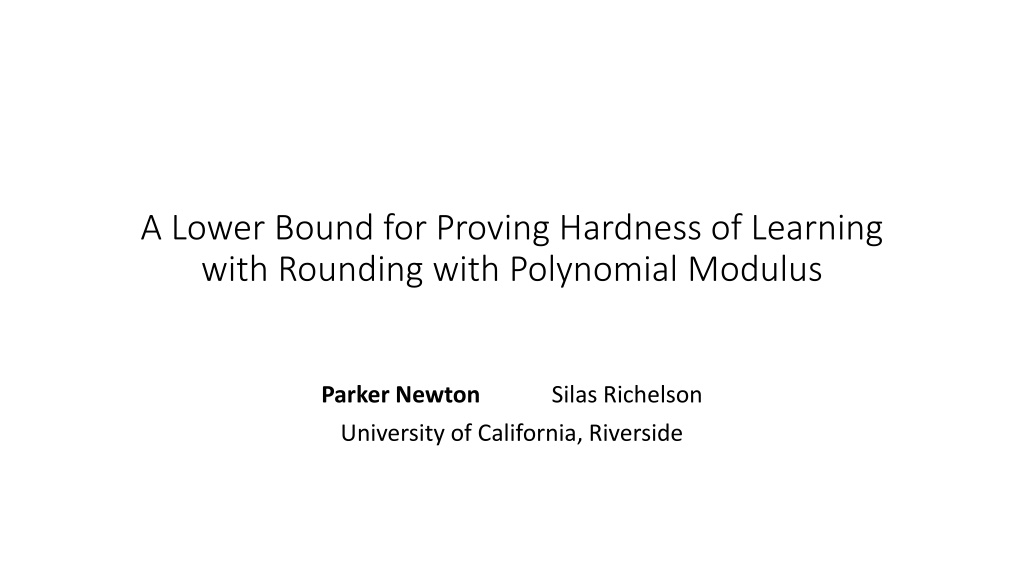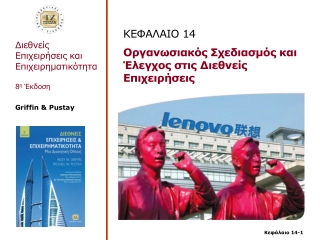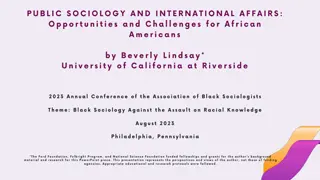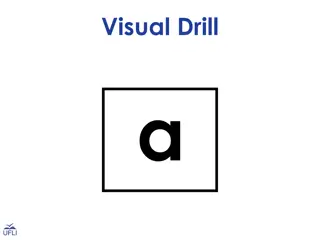
Lower Bound for Proving Hardness of Learning with Rounding
Explore the complexities of learning with rounding in cryptographic systems, including LWE and LWR problems, fundamental hardness assumptions, and constructions of deterministic cryptosystems. Can we directly construct pseudo-random functions from LWR? Delve into the challenges and implications in modern cryptography.
Download Presentation

Please find below an Image/Link to download the presentation.
The content on the website is provided AS IS for your information and personal use only. It may not be sold, licensed, or shared on other websites without obtaining consent from the author. If you encounter any issues during the download, it is possible that the publisher has removed the file from their server.
You are allowed to download the files provided on this website for personal or commercial use, subject to the condition that they are used lawfully. All files are the property of their respective owners.
The content on the website is provided AS IS for your information and personal use only. It may not be sold, licensed, or shared on other websites without obtaining consent from the author.
E N D
Presentation Transcript
A Lower Bound for Proving Hardness of Learning with Rounding with Polynomial Modulus Parker Newton Silas Richelson University of California, Riverside
Learning with Errors [Reg05] The problem of solving a noisy random linear system At least as hard on average as worst-case lattice problems (SVP, SIS) Fundamental hardness assumption for modern crypto SKE, PKE, signatures, TDF s, FHE, ZK, etc. Parameters: Modulus q, dimension n, and error distribution on Zq 2
Learning with Errors LWE s ~ Zqn ai ~ Zqn ei ~ bi = <ai, s> + ei (ai, bi) 3
Learning with Errors LWE s ~ Zqn ai ~ Zqn ei ~ i = 1, , m = poly(n) bi = <ai, s> + ei (ai, bi) 4
Learning with Errors LWE s ~ Zqn ai ~ Zqn ei ~ i = 1, , m = poly(n) bi = <ai, s> + ei (ai, bi) s 5
Learning with Errors LWE s ~ Zqn ai ~ Zqn ei ~ i = 1, , m = poly(n) bi = <ai, s> + ei (ai, bi) s A solves LWE if s = s 6
Deterministic Cryptosystems from LWE Q: Can we construct PRF s directly from LWE? 8
Learning with Rounding [BPR12] Derandomized version of LWE with deterministic error Parameters: Moduli q, p s.t. 2 p < q Dimension n Rounding function R(.): Zq -> Zp which rounds x Zq to the nearest integer (mod p) Ex: p = 2 Rounds to 0 Rounds to 1 Rounds to 0 Zq q/2 q-1 0 9
Learning with Rounding LWR s ~ Zqn ai ~ Zqn bi = R(<ai, s>) i = 1, , m = poly(n) (ai, bi) s A solves LWR if s = s 10
Learning with Rounding Can construct PRF s directly from LWR Hardness of LWR? 11
The Rounding Reduction LWE LWR m {(ai, bi)}i=1m (ai , bi ) = f(ai, bi) i {(ai , bi )}i=1m s ~ B { (ai, bi)}i=1m, ) 12
The Rounding Reduction LWE LWR m {(ai, bi)}i=1m (ai , bi ) = (ai, R(bi)) i {(ai , bi )}i=1m s ~ B { (ai, bi)}i=1m, ) 13
The Rounding Reduction LWE LWR m {(ai, bi)}i=1m (ai , bi ) = (ai, R(bi)) i {(ai , bi )}i=1m s ~ B { (ai, bi)}i=1m, ) Key Idea: Each (ai , bi) ~ LWE(s, ) => (ai , bi ) ~ LWR(s) 14
The Rounding Reduction LWE LWR m {(ai, bi)}i=1m (ai , bi ) = (ai, R(bi)) i {(ai , bi )}i=1m s s ~ B { (ai, bi)}i=1m, ) 15
The Rounding Reduction LWE LWR m {(ai, bi)}i=1m (ai , bi ) = (ai, R(bi)) i {(ai , bi )}i=1m s s ~ B { (ai, bi)}i=1m, ) 16
The Rounding Reduction Works when: q/p is large, e.g. q Bpn (1) [BPR12] q = poly(n) with an a priori upper bound on m m q/(Bpn?), ? 1 [AKPW13] m q/(2Bp) [BGM+16] m q/(Bpn), dimension-preserving [AA16] 17
The Rounding Reduction Works when: q/p is large, e.g. q n (1)[BPR12] q = poly(n) with an a priori upper bound on m m q/(Bpn?), ? 1 [AKPW13] m q/(2Bp) [BGM+16] m q/(Bpn), dimension-preserving [AA16] 18
The Rounding Reduction Works when: q/p is large, e.g. q n (1)[BPR12] q = poly(n) with an a priori upper bound on m [AKPW13, BGM+16, AA16] 19
The Rounding Reduction Works when: q/p is large, e.g. q n (1)[BPR12] q = poly(n) with an a priori upper bound on m [AKPW13, BGM+16, AA16] Large q impacts performance of LWR-based cryptosystems Bounded m restricts certain applications 20
Hardness of LWR Q:Does LWE LWR when q = poly(n) and m is unbounded? LWE with uniform errors LWR in this setting Rejection sampling rounding reduction of [BGM+16] 21
Hardness of LWR Q:Does LWE LWR when q = poly(n) and m is unbounded? LWE with uniform errors LWR in this setting Rejection sampling rounding reduction of [BGM+16] 22
Hardness of LWR Q: Does LWE with non-uniform errors LWR in this parameter setting? Our Result: When q = poly(n), m unbounded, and is an error distribution: Rounding reduction won t work More generally, can t reduce LWE to LWR in non-aborting point- wise manner Any reduction from LWE to LWR can t operate in a non-aborting point-wise manner 23
Hardness of LWR Q: Does LWE with non-uniform errors LWR in this parameter setting? Our Result: When q = poly(n), m unbounded, and is any error distribution for which LWE is hard: Rounding reduction won t work More generally, can t reduce LWE to LWR in non-aborting point- wise manner Any reduction from LWE to LWR can t operate in a non-aborting point-wise manner 24
Hardness of LWR Q: Does LWE with non-uniform errors LWR in this parameter setting? Our Result: When q = poly(n), m unbounded, and is any error distribution for which LWE is hard: Rounding reduction won t work More generally, can t reduce LWE to LWR in non-aborting point- wise manner Any reduction from LWE to LWR can t operate in a non-aborting point-wise manner 25
Hardness of LWR Q: Does LWE with non-uniform errors LWR in this parameter setting? Our Result: When q = poly(n), m unbounded, and is any error distribution for which LWE is hard: Rounding reduction won t work More generally, can t reduce LWE to LWR in non-aborting point- wise manner Any reduction from LWE to LWR can t operate in a non-aborting point-wise manner 26
Hardness of LWR Q: Does LWE with non-uniform errors LWR in this parameter setting? Our Result: When q = poly(n), m unbounded, and is any error distribution for which LWE is hard: Rounding reduction won t work More generally, can t reduce LWE to LWR in non-aborting point- wise manner Any reduction from LWE to LWR can t operate in a non-aborting point-wise manner 27
Reduction from LWE to LWR LWE LWR m {(ai, bi)}i=1m (ai , bi ) = f(ai, bi) i {(ai , bi )}i=1m s ~ B { (ai, bi)}i=1m, ) 28
Reduction from LWE to LWR LWE LWR m {(ai, bi)}i=1m (ai , bi ) = f(ai, bi) i {(ai , bi )}i=1m s ~ B { (ai, bi)}i=1m, ) 29
Reduction from LWE to LWR LWE LWR m {(ai, bi)}i=1m {(ai, bi)}i=1m -> {(ai , bi )}i=1m {(ai , bi )}i=1m s ~ B { (ai, bi)}i=1m, ) 30
Reduction from LWE to LWR LWE LWR m {(ai, bi)}i=1m {(ai, bi)}i=1m -> {(ai , bi )}i=1m {(ai , bi )}i=1m s s ~ B { (ai, bi)}i=1m, ) 31
Reduction from LWE to LWR LWE LWR m {(ai, bi)}i=1m {(ai, bi)}i=1m -> {(ai , bi )}i=1m {(ai , bi )}i=1m s s 32
Pointwise Reduction from LWE to LWR LWE LWR m {(ai, bi)}i=1m (ai , bi ) = f (ai, bi) i {(ai , bi )}i=1m s s Efficient function f: Zqn X Zq -> Zqn X Zp 33
Main Theorem Theorem: Let q, p, n, m be positive integers with q = poly(n) prime, p > q2/3, and m = poly(n). Let be an error distribution on Zq. Then, there does not exist a pointwise reduction from LWE to LWR unless LWE is tractable. 34
Remarks Our result does not suggest that LWR is easy in this parameter setting instead that LWE cannot be reduced to LWR in a non-aborting pointwise manner What about an aborting pointwise reduction? LWE with uniform errors LWR [BGM+16] Conjecture: LWE with non-uniform errors cannot be reduced to LWR in aborting pointwise reduction Restrictions of p > q2/3 and q prime are artifacts of proof 35
Remarks Our result does not suggest that LWR is easy in this parameter setting instead that LWE cannot be reduced to LWR in a non-aborting pointwise manner What about an aborting pointwise reduction? LWE with uniform errors LWR [BGM+16] Conjecture: LWE with non-uniform errors cannot be reduced to LWR in aborting pointwise reduction Restrictions of p > q2/3 and q prime are artifacts of proof 36
Remarks Our result does not suggest that LWR is easy in this parameter setting instead that LWE cannot be reduced to LWR in a non-aborting pointwise manner What about an aborting pointwise reduction? LWE with uniform errors LWR [BGM+16] Conjecture: LWE with non-uniform errors cannot be reduced to LWR in aborting pointwise reduction Restrictions of p > q2/3 and q prime are artifacts of proof 37
Remarks Our result does not suggest that LWR is easy in this parameter setting instead that LWE cannot be reduced to LWR in a non-aborting pointwise manner What about an aborting pointwise reduction? LWE with uniform errors LWR [BGM+16] Conjecture: LWE with non-uniform errors cannot be reduced to LWR in aborting pointwise reduction Restrictions of p > q2/3 and q prime are artifacts of proof 38
Remarks Our result does not suggest that LWR is easy in this parameter setting instead that LWE cannot be reduced to LWR in a non-aborting pointwise manner What about an aborting pointwise reduction? LWE with uniform errors LWR [BGM+16] Conjecture: LWE with non-uniform errors cannot be reduced to LWR in an aborting pointwise manner Restrictions of p > q2/3 and q prime are artifacts of proof 39
Remarks Our result does not suggest that LWR is easy in this parameter setting instead that LWE cannot be reduced to LWR in a non-aborting pointwise manner What about an aborting pointwise reduction? LWE with uniform errors LWR [BGM+16] Conjecture: LWE with non-uniform errors cannot be reduced to LWR in an aborting pointwise manner Restrictions of q prime and p > q2/3 are artifacts of proof 40
Main Idea The algebraic and combinatorial structure of the function f of a pointwise reduction from LWE to LWR can be exploited to directly solve LWE. 41
Correctness of Pointwise Reduction f {(ai, bi)}i=1m ~ LWE(s, )m {(ai , bi )}i=1m ~ LWR(s )m 42
Correctness of Pointwise Reduction Suppose correctness does not hold. 43
Correctness of Pointwise Reduction Suppose correctness does not hold. Input: {(ai , bi )}i=1m 44
Correctness of Pointwise Reduction Suppose correctness does not hold. Input: {(ai , bi )}i=1m If s s.t. bi = R(<ai , s >) i, then output s . Otherwise output . 45
Correctness of Pointwise Reduction LWE LWR s ~ Zqn m {(ai, bi)}i=1m ~ LWE(s, )m (ai , bi ) = f (ai, bi) i {(ai , bi )}i=1m s 46
Correctness of Pointwise Reduction LWE LWR s ~ Zqn m {(ai, bi)}i=1m ~ LWE(s, )m (ai , bi ) = f (ai, bi) i {(ai , bi )}i=1m s Contradicts the assumed hardness of LWE! 47
Lemma: Let q, p, n, m be positive integers with q = poly(n) prime, p > q2/3, and m = poly(n). Let be an error distribution on Zq . If there exists a pointwise reduction (f, B) from LWE to LWR, then there exists a matrix H Zqn X n such that rank(H) n - O(1) and w.h.p. over s ~ Zqn, Pr(a, b) ~ LWE(s, )[ a = Ha] , where (a , b ) = f(a, b). 48
Main Theorem Theorem: Let q, p, n, m be positive integers with q = poly(n) prime, p > q2/3, and m = poly(n). Let be an error distribution on Zq. Then, there does not exist a pointwise reduction from LWE to LWR unless LWE is tractable. 49
Proof Sketch s ~ Zqn {(ai, bi)}i=1m ~ LWE(s, )m f {(ai , bi )}i=1m ~ LWR(s)m => Each (ai , bi ) = (Ha, <Ha, s >) = (Ha, R(<a, Hts>)) w.p. 50






















